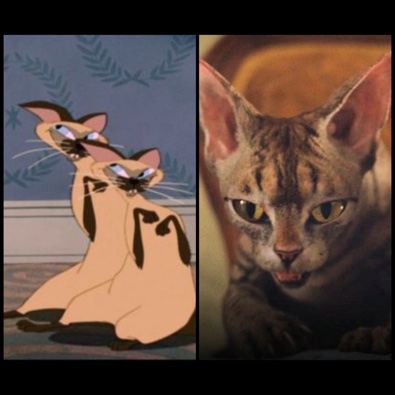Reimagining Ethnic Stereotypes
kawaiidaigakusei at Dec. 16, 2019, midnight

Following the release of Disney’s latest streaming device, I have had the opportunity to watch the newest live action movie of Lady and the Tramp based on the 1955 animated version of the same name. I would be remiss not to to say that I started my subscription mainly because of a morbid curiosity to see how the modern animators handled a couple of scenes in the movie.
First, one of my favorite (albeit controversial) scenes from Lady and the Tramp is when a pair of twin Siamese cats walk out of a picnic basket and begin singing the song “We Are Siamese if You Please” around the upper middle class cocker-spaniel, Lady. When I was younger, I saw the scene as Asian representation, and yes, I grew up to realize it was not perfect. In recent times, using the term Siamese (a reference to Siam, modern day Thailand) has been edited out of our vernacular. Due to the sensitive treatment of cultural stereotypes, the Lady and the Tramp live action remake has switched out the pair of Siamese cats and replaced them with two Devon Rex cats with tabby-like patterns on their back. The 1955 song “We Are Siamese if You Please” song has been gutted from the film and replaced with a brand new song “What a Shame”. When I first saw the newer updated version, I immediately turned to the 1955 version to assess if it needed to be edited or if the original was problematic. Rewatching the two versions made me rethink whether editing the original version solves all the problems associated with the original scene or brings up the problem of ignoring to discuss why the original scene was included in the first place.
Additional edits to the original version also included new casting for some of the original Italian restaurant employees who sang the song “Bella Notte” and recasting some of the original human characters.
So at the end of the day, while it is a step in a new direction to remake entire scenes from older movies to fit the acceptable trends in mainstream thinking , I am so glad and overjoyed that the original version of Lady and the Tramp (1955) still exists in its unedited and still controversial version because it was the one I watched as a kid. I do not believe in editing history or pretending that certain scenes did not happen. The animated Lady and the Tramp film was made during a time that Asian American civil rights were being shaken up and stereotypical depictions of Asian characters still ended up in film. It is important to be aware that it was part of mainstream thought and not ignore and bury history and replace it with newer, edited version.
.::.
What's Quacking?
Do you have any original art to contribute to our stock image database, announcements, community projects, ideas, news, or milestones to report? Please leave general comments below or send a PQ to kawaiidaigakusei. Email me at kawaiidaigakusei(at)gmail(dot)com.


Comments
Please login to comment.
Login or Register${ comment.author }} at
${ comment.author }} at